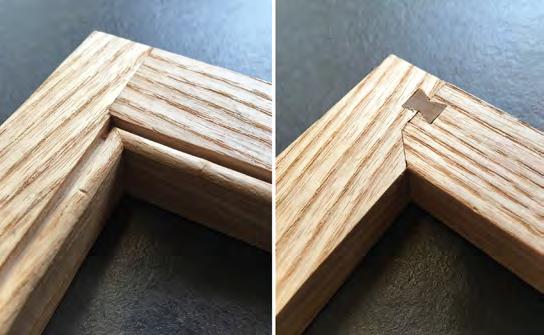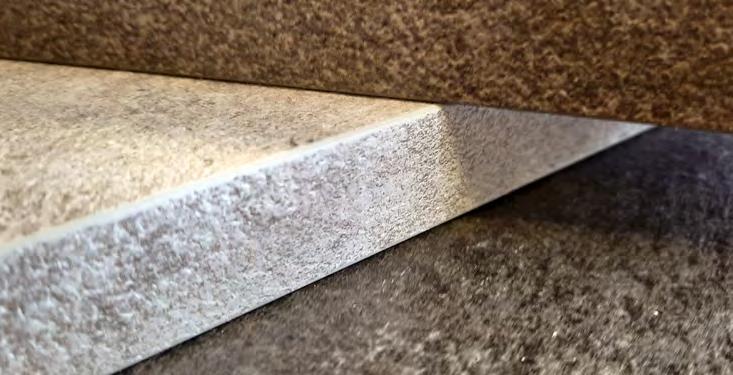
5 minute read
Creating heavenly staircases with HOMAG CENTATEQ CNC machining centres
Beautifully crafted staircases can add a wow factor to almost any residential or commercial property. Historically, however, producing intricate wooden staircases has been a labour of love, requiring hundreds of hours of a craftsman’s time. This often made such projects prohibitively expensive. Now, with three-, four- or five-axis CNC machining centres, the world of complex wooden staircases is well within reach for almost any joinery company.
If you are looking to upgrade your capability to produce high quality staircases with a CNC machining centre there are several important features to consider. Top of the list without a doubt is precision. A high-end CNC machine has to be able to produce precise cuts and designs to ensure the final product meets the desired specifications.
Speed and ease of use come a very close second and third on the list of desirable characteristics. A machine with a high processing speed will be able to complete projects more efficiently. Whilst a CNC with user-friendly controls and software will make it easier for your team to operate and produce high quality products.
Look for a machine with a robust build quality
It goes almost without saying that whichever CNC you buy you need to ensure it can handle the different types of wood you will be using for projects. Machine build quality is another vitally important element. You want a CNC machining centre that will work day in, day out, withstanding the demands of continuous use in your woodworking production facility. Downtime costs money, so a robust CNC is essential if you are to consistently hit delivery schedules.
Of course a CNC, by its very nature, is a complex piece of machinery so there will be occasions when issues arise. When this happens you want a machine that is easy to maintain, has readily available spares and is well supported by the machine manufacturer’s own team of service engineers. If the problem can’t be solved remotely, you want engineers who can respond to call-outs very quickly.
Cost is less important than lifetime value
Making a purchase decision primarily on cost is rarely a good idea. You may be tempted by the initial low cost but beware, quality and performance usually come with a higher initial price tag; the lifetime cost, however, tends to be much lower and there are always finance options to overcome initial funding issues. More important perhaps are the CNC’s features and capabilities; the machine must be able to manufacture the high quality products you want to produce. HOMAG makes around 2000 CNC machines a year, ranging from standalone machines to fully automated solutions. The company is the market and competence leader offering three-, four- and five-axis models with pod and rail, auto and nesting table options. A wide range of clamping systems and setup aids further enhance the versatility of its CNC machining centres.
To ensure the HOMAG CNCs are easy to operate, the company has developed close working relationships with the leading developers of staircase CAD-CAM manufacturing software and systems.
Manufacturing staircase components can be complex
Staircases comprise of a widely varying set of components including strings (the housing on either side of a flight of stairs into which the treads and risers are fixed), treads (the horizontal part of the step that a person will stand on), newel posts (the large post found at the foot and at the top of any flight of stairs) and handrails. Staircases can have straight flights, winder kites (stairs with a straight flight and steps which turn at the bottom), or be curved.
The size and jointing of the components is based upon the shape of the building, the size of the well hole (also known as a ‘stairwell’), the floor to floor height (known as the ‘rise’), the going or go (the length along the floor a straight flight of stairs projects) and the customer’s design. All these variable factors require the highly accurate and consistent production of the necessary components of a set of stairs.
HOMAG’s range of CENTATEQ CNC machining centres has been designed to provide everything from an all-round solution for the small- to medium-sized manufacturer to multiple machines dedicated to component types, for example one machine for kites, one for strings, one for newel posts.

All components can be machined using HOMAG’s woodWOP control software, but the CENTATEQs are also compatible with the majority of staircase manufacturing systems.
Fve-axis CENTATEQ P-210: a fast, versatile all-rounder
Ease of operation was a key factor in the design of HOMAG’s CNC machining centre, the CENTATEQ P-210. All of the essential functions are clearly in view and mounted directly on the machine. The large window means processing is always visible and the access to the table is unobstructed with no fences to the left or right. Fully implemented bumpers enable productivity, security and easy access to the machine.
When fitted with an auto table, parts can be split automatically and moved apart for the machining of radii or to make room for a sanding aggregate. The same machine can be used to manufacture other components of the staircase. The five-axis CNC provides the ability to machine a central round edged tenon which creates a better, higher quality joint than a bare faced tenon.
A five-axis model can make cut strings and cut out the intersection between the tread and the riser. Otherwise, this would have to be done manually. The five-axis CENTATEQ P-210 also has the ability to machine cut string winder type staircases where the angle of the riser changes progressively in the winder.
When clamping workpieces the overhead laser option makes this task quick and easy. The laser reads the contour of the workpiece or operation and projects the complete contour onto the machine bed. Initially, the laser projects to pod height showing the operator where to position the pods and then, via a button press on the remote control, the laser takes account of the material thickness and shows the operator where to position the material on the pods.
This makes set up for special one off parts extremely quick, allowing the operator to correct mistakes if the material has been laminated incorrectly. It allows movement of the timber underneath the contour cutting line to avoid knots or unsightly areas of the timber.
For the machining of newel posts and wreath handrails HOMAG offers specific clamps. The newel post clamps allow for the complete machining of a newel – cutting to length, mortise, draw bore and the machining of end cappings. The clamps provide an accurate datum and, as the parts are held pneumatically, a high quality finish is always achieved.
Commenting on HOMAG’s CENTATEQ range of CNC machining centres, Phil Ptichford, CNC Product Manager for HOMAG UK said: “The HOMAG CNCs offer versatility, consistent high quality and ease of use, particularly for staircase, window and door manufacturers.
“These technically advanced machines have set the benchmark for the industry and are proving to be extremely popular with specialist joinery companies. They are robust, fast and versatile whether used for nesting or specialist joinery applications.” www.homag.com
For a demonstration or more information on the CENTATEQ range of CNC machining centres or other HOMAG machinery and software solutions, contact Adele Hunt at HOMAG UK on 01332 856424.










